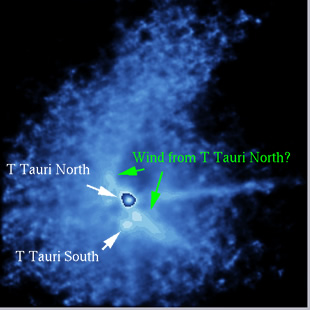T Tauri Stars
The class of stars known as T Tauri stars is one for which the intensity varies erratically. The stars in the class have a wide range of spectral types and may vary in intensity by several magnitudes. They are strong infrared emitters. T Tauri stars are characterized by strong emission lines that overwhelm the absorption lines. The presumption is that these are stars that have not yet reached the main sequence and settled down to a steady and predictable behavior. The intense emission behavior is thought to be associated with an extensive chromosphere surrounding the young stars.

T Tauri stars tend to be found in close proximity to each other in groupings known as T associations. There is also an association with bright nebulous regions of gas and dust known as Herbig-Haro objects. The prototype star T Tauri is embedded in the brightest Herbig-Haro object.
 | The protype star T Tauri (a binary system) can be seen to be embedded in a complex environment in this high-resolution infrared image. In addition to the nebulosity of the Herbig-Haro object, there are jets and other features indicative of high activity. Many T Tauri stars are accompanied by discs of material which may be the precursors of proto-planetary discs of the future main-sequence stars. There is discussion of the possibility that the Sun may have gone through a T Tauri stage about five billion years ago. Image accessed on the Swinburne site, image credit C. and F. Roddler Institute for Astronomy, Honolulu, Hawaii. |
The consensus seems to be that T Tauri stars are newly formed stars (< 10 million years old) of low to intermediate mass (<3 solar masses) that are in the process of gravitational collapse but have yet to reach the temperature necessary for nuclear fusion to have started. The time for this collapse would be very short if it were just a freefall collapse, but the collapse is impeded by radiation pressure and other effects. The collapse time to nuclear ignition may be 100 million years (Swinburne), so the great luminosity of these intermediate stage stars comes from their great size and the active atomic processes fueled by the energy of gravitational collapse.
Star concepts
Pasachoff, Ch 6.
T Tauri Wiki
T Tauri Swinburne
| HyperPhysics***** Astrophysics | R Nave |